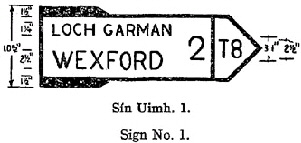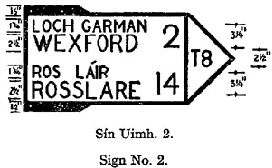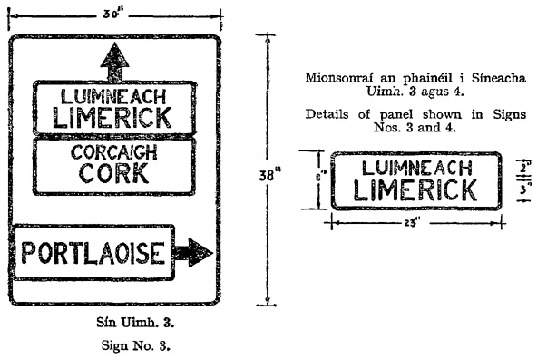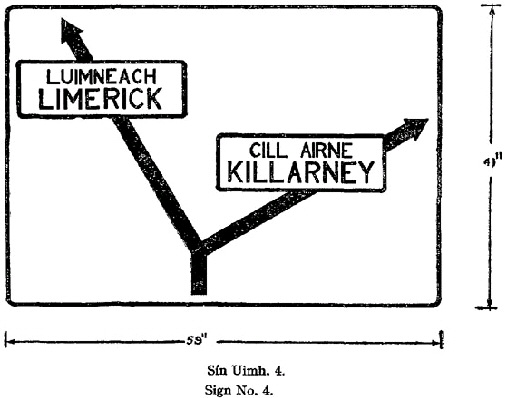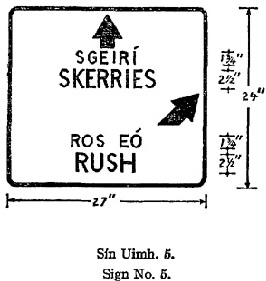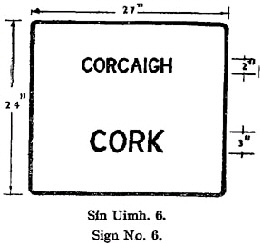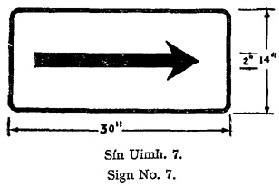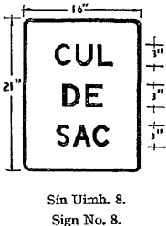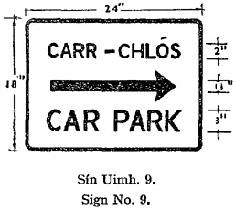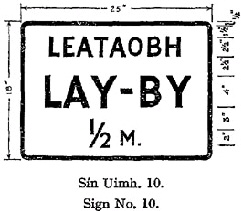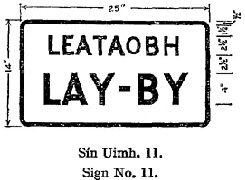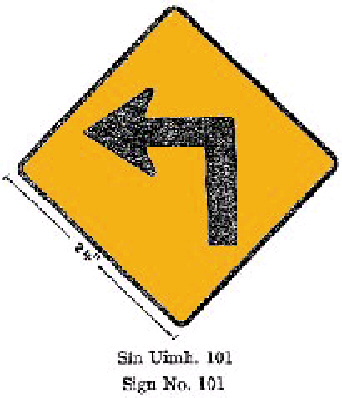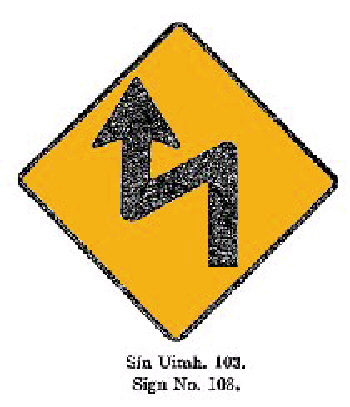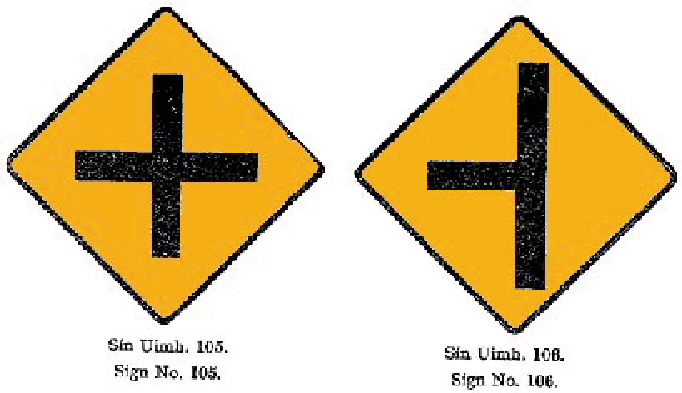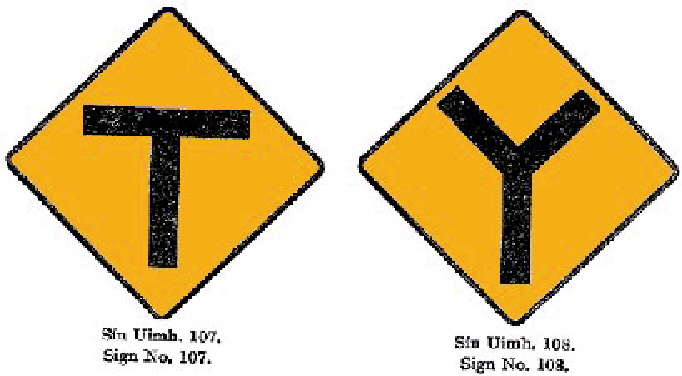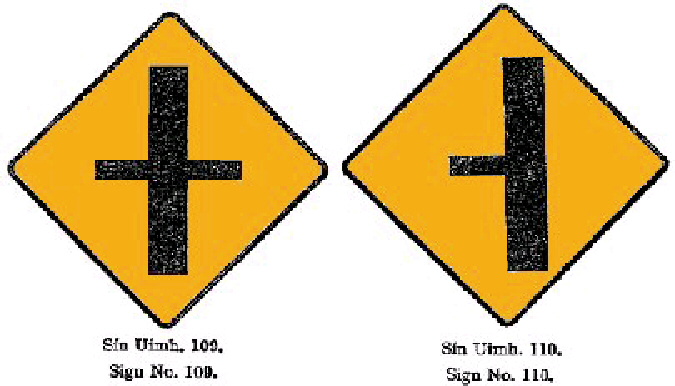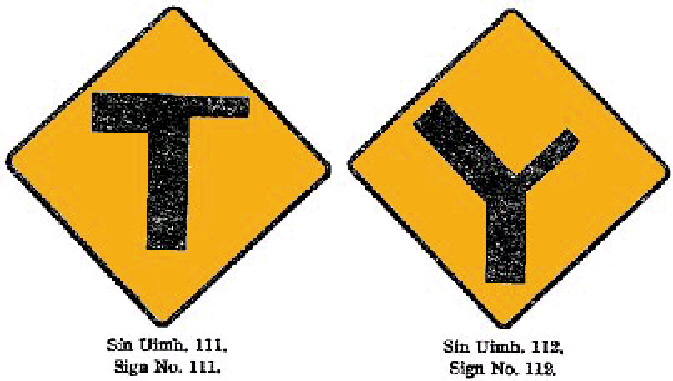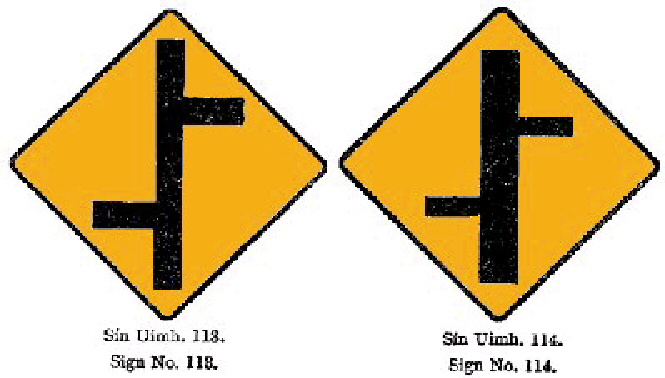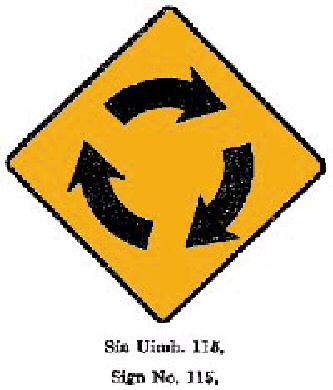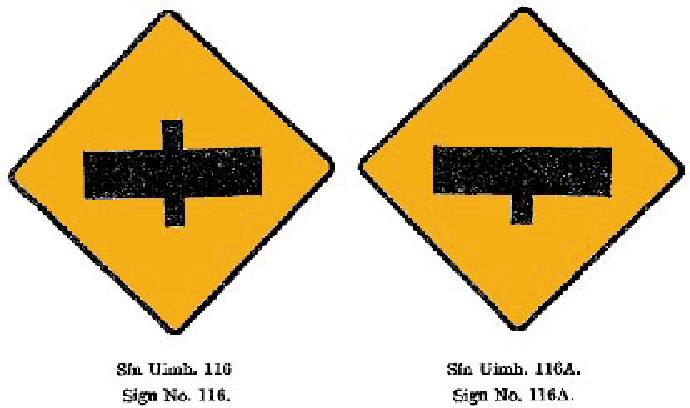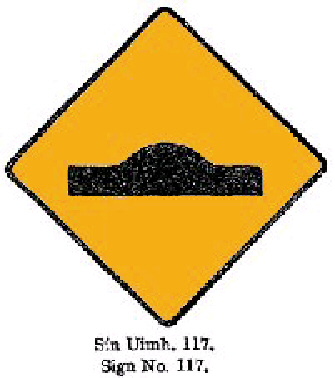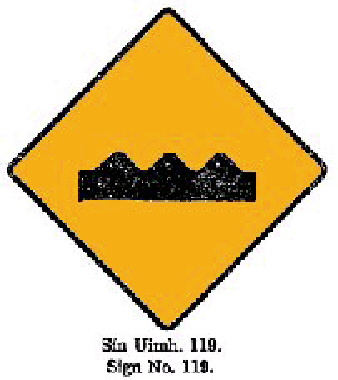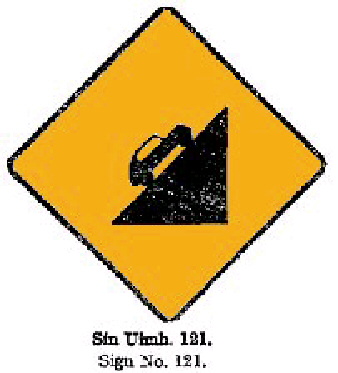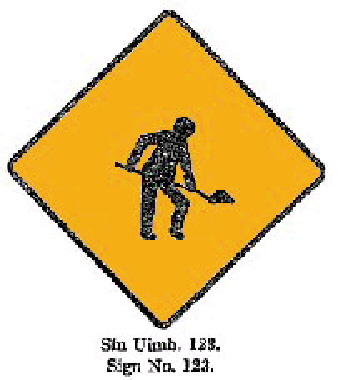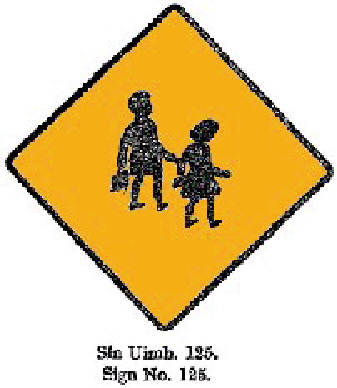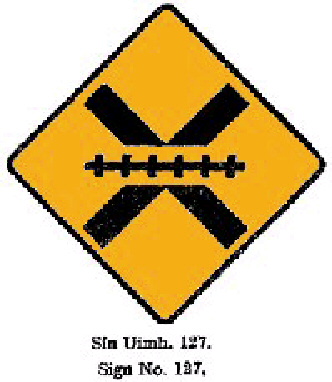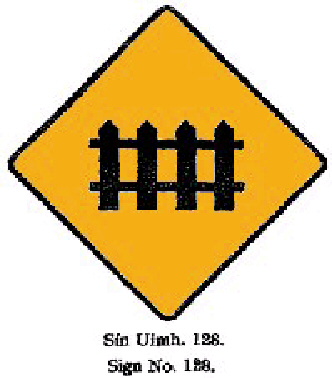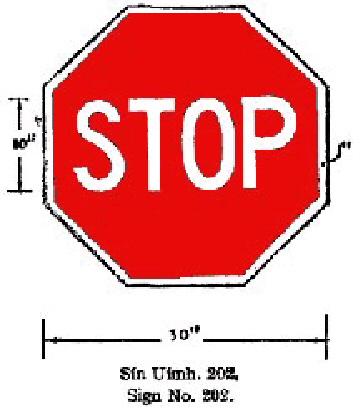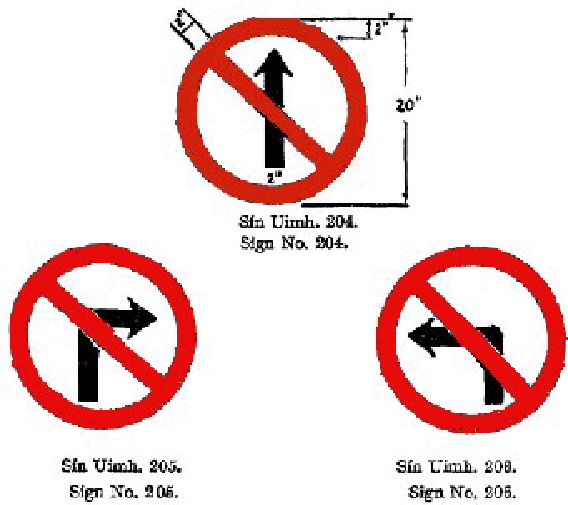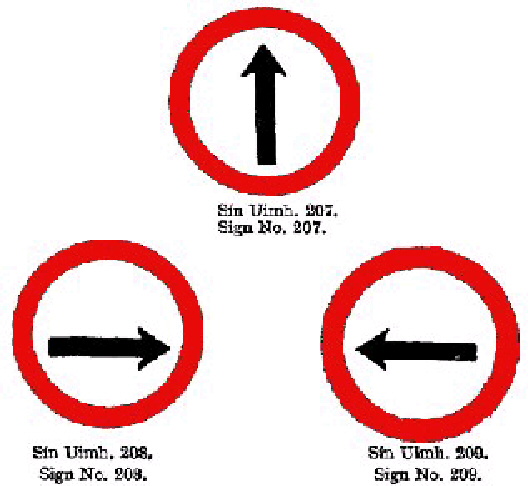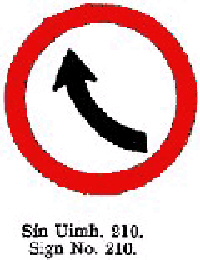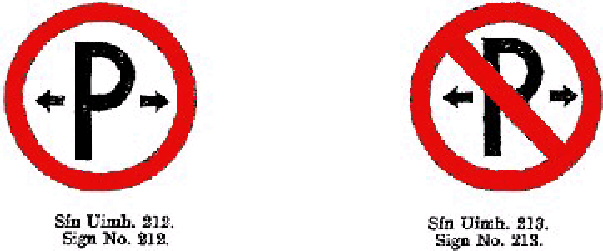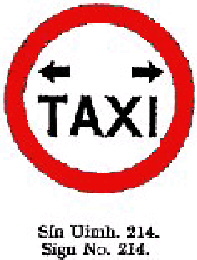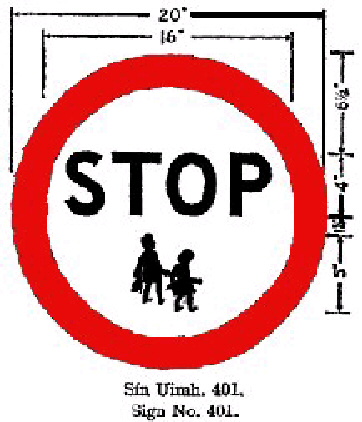S.I. No. 171/1962 -- Road Traffic (Signs) Regulations, 1962.
|
S.I. No. 171/1962: ROAD TRAFFIC (SIGNS) REGULATIONS, 1962. |
||||||||||||
|
ROAD TRAFFIC (SIGNS) REGULATIONS, 1962. |
||||||||||||
|
The Minister for Local Government, in exercise of the powers vested in him by sections 5 , 86 , 95 and 96 of the Road Traffic Act, 1961 (No. 24 of 1961) hereby makes the following Regulations :-- |
||||||||||||
|
PART I PRELIMINARY AND GENERAL |
||||||||||||
| Citation and Revocations. | ||||||||||||
|
1.--(1) These Regulations may be cited as the Road Traffic (Signs) Regulations, 1962. |
||||||||||||
|
(2) The Traffic Wardens Regulations, 1955 ( S.I. No. 246 of 1955 ), the Traffic Signs Regulations, 1956 ( S.I. No. 284 of 1956 ), the Traffic Signs (Amendment) Regulations, 1959 ( S.I. No. 57 of 1959 ) and the Traffic Signs (Amendment) Regulations, 1961 ( S.I. No. 67 of 1961 ) are hereby revoked. |
||||||||||||
| Definitions. | ||||||||||||
|
2.--(1) In these Regulations, save where the context requires otherwise, the following expressions shall have the meanings hereby assigned to them :-- |
||||||||||||
|
" the Act " means the Road Traffic Act, 1961 (No. 24 of 1961); |
||||||||||||
|
" bus stop sign " means a sign to indicate a stopping place or stand for omnibuses provided under or in pursuance of section 86 of the Act; |
||||||||||||
|
" design " when used in relation to an upright sign means the layout of the sign and includes the relative size and position of any symbols, figures, letters or other markings shown thereon. |
||||||||||||
|
" dual carriageway " means a road the roadway of which is divided centrally so as to provide two separate carriageways, on each of which traffic is required by a road regulation to proceed in one direction only; |
||||||||||||
|
" informative sign " means an upright sign which gives information in regard to a road, including the places to which the road leads and the distances to or from such places; |
||||||||||||
|
" left " and " right " shall be construed with reference to the direction in which traffic is facing; |
||||||||||||
|
" the Minister " means the Minister for Local Government; |
||||||||||||
|
" one-way roadway " means a roadway the traffic on which is for the time being required by a road regulation to proceed in one direction only; |
||||||||||||
|
" pedestrian crossing " means a portion of the roadway specially marked for use by pedestrians crossing the road; |
||||||||||||
|
" regulatory sign " means an upright sign which indicates the existence of a road regulation in relation to a road, or implements such a regulation, or both, or which indicates that a built-up area speed limit applies or ceases to apply to a road or roads; |
||||||||||||
|
" road " means a public road; |
||||||||||||
|
" road regulation " shall have the same meaning as that assigned to it by subsection (1) of Section 95 of the Act. |
||||||||||||
|
" roadway markings " means markings placed on the surface of the roadway; |
||||||||||||
|
" roundabout " means a road junction so constructed that traffic which enters it must proceed slowly in a circular direction; |
||||||||||||
|
" route letter and number " means the route letter and number assigned to the route comprising such road by the Minister in any classification of roads made by him under subsection (2) of section 17 of the Ministry of Transport Act, 1919; |
||||||||||||
|
" staggered road junction " means a sequence of two road junctions in close proximity, the second junction occurring on the opposite side to the first; |
||||||||||||
|
" traffic " does not include pedestrians, and where " traffic " is referred to as having rights or obligations the word shall connote the persons driving the vehicles concerned, or driving, riding, managing or controlling the animals concerned; |
||||||||||||
|
" traffic refuge " means a refuge for pedestrians on a roadway provided by a raised pavement, guard posts or similar means; |
||||||||||||
|
" traffic sign " shall have the same meaning as that assigned to it by subsection (1) of section 95 of the Act. |
||||||||||||
|
" upright sign " means a traffic sign (other than a lamp, roadway or wall marking, or instrument for giving signals by mechanical means) erected on or beside a road, or suspended over a road; |
||||||||||||
|
" warning sign " means an upright sign which warns persons of danger in relation to a road, or advises the precautions to be taken against such danger, or both; |
||||||||||||
|
(2) For the purposes of Chapters IV and V of Part II and of Part III of these Regulations-- |
||||||||||||
|
(a) " white " includes stainless steel and polished aluminium; |
||||||||||||
|
(b) " black " includes the colour of the surface of the roadway where that colour offers a reasonable contrast to white; |
||||||||||||
|
(c) a continuous line, or a segment of a broken line, may be effected by placing studs side by side or end to end. |
||||||||||||
|
PART II REGULATIONS WITH RESPECT TO TRAFFIC SIGNS PURSUANT TO SECTION 95 OF THE ACT |
||||||||||||
|
Chapter I Informative Signs |
||||||||||||
| Informative Signs. | ||||||||||||
|
3.--(1) An informative sign shall show the information given in black letters, figures and markings on a white background surrounded by a black border. |
||||||||||||
|
(2) Place-names shall be shown in Roman letters in Irish and in English and where the spelling of a place-name is the same in both languages one inscription only need be shown on the sign. |
||||||||||||
|
(3) The shapes, dimensions and designs of informative signs, and the significance to be attached thereto, shall be as set out in Parts I, IV and VII of the First Schedule hereto. |
||||||||||||
|
(4) Notwithstanding the provisions of paragraphs (1) and (3) of this Article an informative sign to indicate the name of a city or town on an important route may show the information given in white letters on a dark background surrounded by a white border, the dimensions of the sign and of the letters being varied to suit the circumstances. |
||||||||||||
|
Chapter II Warning Signs |
||||||||||||
| Warning Signs. | ||||||||||||
|
4.--(1) A warning sign shall consist of a yellow diamond (being a square with one diagonal vertical, the corners being rounded), on which shall be shown in black a symbol to indicate the nature of the hazard to be met, the yellow diamond being surrounded by a black border. |
||||||||||||
|
(2) The following shall be as set out in Parts II, V and VII of the First Schedule hereto:-- |
||||||||||||
|
(a) the dimensions and designs of warning signs; |
||||||||||||
|
(b) the symbols to be used thereon; |
||||||||||||
|
(c) the significance to be attached thereto. |
||||||||||||
|
Chapter III Regulatory Signs |
||||||||||||
| Major Road Ahead Sign. | ||||||||||||
|
5.--(1) The regulatory sign to indicate that a road ahead is a major road, the traffic on which has the right of way over traffic approaching from the road on which the sign is provided, shall consist of a red inverted equilateral triangle with rounded corners, the space inside the triangle being coloured white on which shall be shown in black letters the words " Yield Right of Way " or " Géill Sli "; |
||||||||||||
|
(2) The dimensions and design of the sign to which this article applies shall be as set out in Section A of Part III and in Part VII of the First Schedule hereto. |
||||||||||||
| Stop Sign. | ||||||||||||
|
6.--(1) The regulatory sign to indicate-- |
||||||||||||
|
(a) that a road ahead is a major road, the traffic on which has the right of way over traffic approaching from the road on which the sign is provided, and |
||||||||||||
|
(b) that traffic so approaching the road ahead must halt before entering it, |
||||||||||||
|
shall consist of a red octagon with a white border and showing the word " Stop " in white letters. |
||||||||||||
|
(2) The dimensions and design of the sign to which this article applies shall be as set out in Section B of Part III and in Part VII of the First Schedule hereto. |
||||||||||||
| End of Speed Limit Sign. | ||||||||||||
|
7.--(1) The regulatory sign to indicate the end of a stretch of road to which a built-up area speed limit or a special speed limit applies shall consist of a white disc crossed obliquely by a black bar. |
||||||||||||
|
(2) The dimensions and design of the sign to which this article applies shall be as set out in section C of Part III and Part VII of the First Schedule hereto. |
||||||||||||
| Other Regulatory Signs. | ||||||||||||
|
8.--(1) A regulatory sign (other than a major road ahead sign, a stop sign or an end of speed limit sign) shall consist of a white disc with a red border, appropriate symbols, figures or letters being shown in black on the disc, an oblique red bar being added whenever a prohibition is indicated. |
||||||||||||
|
(2) The following shall be as set out in section D of Part III and in Parts VI and VII of the First Schedule hereto :-- |
||||||||||||
|
(a) the dimensions and designs of signs to which this article applies; |
||||||||||||
|
(b) the symbols, figures and letters to be used on such signs; |
||||||||||||
|
(c) the significance to be attached to such signs. |
||||||||||||
|
Chapter IV Pedestrian Crossings |
||||||||||||
| Pedestrian Crossings Signs. | ||||||||||||
|
9.--(1) Subject to paragraph (2) of this article, the traffic sign to indicate a pedestrian crossing shall consist of roadway markings formed by two parallel continuous white lines each approximately six inches wide and not less than six feet nor more than twenty feet apart, extending, where there is no traffic refuge at the crossing, across the full width of the road and, where there is a traffic refuge at the crossing, from the edge of each side of the roadway to the nearer limit of the traffic refuge. |
||||||||||||
|
(2) The traffic signs to indicate a pedestrian crossing at which traffic is not normally controlled by traffic lights or by a member of the Garda Síochána in uniform and at which pedestrians have the right of way when traffic is not so controlled shall consist of-- |
||||||||||||
|
(a) the roadway markings described in paragraph (1) of this article and |
||||||||||||
|
(b) a beacon at or near each end of the crossing and, where there is a traffic refuge at the crossing, a beacon on the traffic refuge, each beacon emitting, save as is provided in paragraph (3) hereof, at regular intervals flashes of yellow light at the rate of not more than forty-five and not less than thirty-five flashes a minute, and |
||||||||||||
|
(c) roadway markings consisting of alternate black and white stripes drawn parallel to the line of the roadway within the limits of the roadway markings described in paragraph (1) of this article and extending longitudinally to within approximately six inches of each of the said markings, each stripe being not less than one foot nine inches and not more than two feet three inches wide except the stripe at the edge of each side of the roadway which shall be not less than two feet and not more than four feet wide and shall be black in colour. |
||||||||||||
|
(3) The requirement that each beacon at a pedestrian crossing shall emit a flashing light shall not apply as respects a crossing at which for the time being one and only one of the beacons has failed so to light. |
||||||||||||
|
(4) In this article " beacon " means a spherical globe which is yellow in colour and approximately one foot in diameter and is mounted not less than seven feet and not more than fourteen feet above the surface of the ground in the immediate vicinity. |
||||||||||||
|
Chapter V Roadway Markings |
||||||||||||
| Pedestrian Crossings. | ||||||||||||
|
10. The roadway markings to indicate a pedestrian crossing shall be as set out in Article 9 of these Regulations. |
||||||||||||
| Stop-lines. | ||||||||||||
|
11.--(1) A stop-line may be used to indicate the point beyond which traffic shall not proceed when halting in compliance with a road regulation. |
||||||||||||
|
(2) A stop-line shall consist of a continuous white line, not less than eight inches and not more than ten inches wide, extending in the case of a one-way roadway, across the full width of the roadway and, in any other case, across the roadway from the left edge to the centre thereof. |
||||||||||||
| Other Roadway Markings. | ||||||||||||
|
12. The following roadway markings having the following significance may be used :-- |
||||||||||||
|
(a) a continuous white line, approximately four inches wide, and extending not less than sixty feet along the centre of the roadway--to indicate that traffic must keep to the left of such line; |
||||||||||||
|
(b) a broken white line, extending along the centre of the roadway, and consisting of segments approximately four inches wide, three feet long and fifteen feet apart--to indicate that traffic must keep to the left of such line unless circumstances indicate that it can be crossed without danger to other traffic or pedestrians; |
||||||||||||
|
(c) a broken white line, consisting of segments approximately four inches wide, three feet long and three feet apart (or fifteen feet apart on a dual carriageway)--to indicate the boundary of a traffic lane; |
||||||||||||
|
(d) white arrows, placed in traffic lanes at an approach to a road junction, to indicate to traffic the direction to be taken by traffic using such lanes, as follows :-- |
||||||||||||
|
(i) in the case of arrows pointing straight ahead, that traffic using the lane in which such arrows are placed shall proceed straight through the junction, |
||||||||||||
|
(ii) in the case of arrows pointing or curved to the left, that traffic using the lane in which such arrows are placed shall turn left at the junction, |
||||||||||||
|
(iii) in the case of arrows pointing or curved to the right, that traffic using the lane in which such arrows are placed shall turn right at the junction; |
||||||||||||
|
(e) a white line terminating in an arrowhead and with an additional arrowhead branching from it to the left or to the right placed in a traffic lane at an approach to a road junction to indicate to traffic the direction to be taken by traffic using such lane, as follows :-- |
||||||||||||
|
(i) where the additional arrow branches to the left, that the traffic using the lane in which the marking is placed shall either proceed straight through the junction or shall turn left at the junction, |
||||||||||||
|
(ii) where the additional arrow branches to the right, that the traffic using the lane in which the marking is placed shall either proceed straight through the junction or shall turn right at the junction; |
||||||||||||
|
(f) a broken yellow line, extending along the edge of the roadway and consisting of segments approximately four inches wide, three feet long and three feet apart--to indicate at a road junction the line of the edge of the roadway of an important road. |
||||||||||||
|
Chapter VI |
||||||||||||
|
Traffic Lights, etc. |
||||||||||||
| Traffic Lights. | ||||||||||||
|
13.--(1) Any of the following types of mechanical signals may be used to control traffic :-- |
||||||||||||
|
(a) a set of three lamps, which shall comply with the following conditions :-- |
||||||||||||
|
(i) the lamps shall face the stream of traffic it is intended to control; |
||||||||||||
|
(ii) the lamps shall show red, amber and green lights respectively when lit; |
||||||||||||
|
(iii) the lamps shall be arranged vertically, that showing a red light when lit being uppermost and that showing a green light when lit being lowest; |
||||||||||||
|
(iv) each lamp shall be separately illuminated and the effective diameter of the lens thereof shall be not less than eight inches and not more than eight inches and a half; |
||||||||||||
|
(v) the centre of the lens of a lamp shall be not more than fifteen inches from that of the lamp immediately next to it; |
||||||||||||
|
(vi) each lamp shall be lighted and extinguished in turn, at intervals determined by an automatic or manually operated device; |
||||||||||||
|
(vii) the lower edge of the lowest lamp shall be not less than seven feet and not more than ten feet above the surface of the ground in the immediate vicinity; |
||||||||||||
|
(b) a set of three lamps complying with the conditions in sub-paragraph (a) of this paragraph save that a lamp showing when lit a green arrow on a black field may be substituted for the lamp showing a green light when lit; |
||||||||||||
|
(c) a set of four lamps, three of which shall comply with the conditions in either sub-paragraph (a) or sub-paragraph (b) of this paragraph and the fourth of which shall-- |
||||||||||||
|
(i) comply with conditions (i), (iv), (v) and (vi) of sub-paragraph (a) of this paragraph; |
||||||||||||
|
(ii) be placed beside the lowest lamp referred to in sub-paragraph (a) or sub-paragraph (b) of this paragraph, and |
||||||||||||
|
(iii) show, when lit, a green arrow on a black field. |
||||||||||||
|
(2) Where because of road works or for some other reason, the width of a roadway is temporarily restricted so that it will accommodate only one line of traffic, a set of two lamps may be used which comply with conditions (i), (iv) and (vi) of sub-paragraph (a) of the preceding paragraph and with the following conditions :-- |
||||||||||||
|
(i) the lamps shall show red and green lights respectively when lit; |
||||||||||||
|
(ii) the lamps shall be arranged vertically, that showing a red light when lit being placed above the other; |
||||||||||||
|
(iii) the centres of the lenses of the lamps shall be not more than twenty-four inches apart; |
||||||||||||
|
(iv) the lower edge of the lower lamp shall be not less than five feet and not more than ten feet above the surface of the ground in the immediate vicinity. |
||||||||||||
|
(3) (a) When a lamp shows a red light it shall signify that the stream of traffic controlled by such signal shall not proceed beyond the stop line on the roadway at such signal, or beyond the signal if there is no stop line. |
||||||||||||
|
(b) When a lamp shows an amber light while another lamp shows a red light it shall signify an impending extinguishment of the red light but shall not signify that the stream of traffic controlled by such signal may proceed before the extinguishment of the red light. |
||||||||||||
|
(c) When a lamp shows a green light (other than a green arrow) it shall signify that the stream of traffic controlled by such signal may proceed past such signal. |
||||||||||||
|
(d) When a lamp shows an amber light alone it shall signify that any portion of the stream of traffic controlled by such signal which is, at the beginning of the illumination of such amber light, so close to the stop line on the roadway at such signal that it cannot safely stop before crossing that line may proceed past such signal but that all other portions of the said stream of traffic shall not proceed beyond the said stop line. |
||||||||||||
|
(e) When a lamp shows, when lit, a green arrow it shall signify, notwithstanding any other indication given by the signals, that the stream of traffic controlled by such signal may proceed in the direction indicated by such arrow. |
||||||||||||
| Pedestrian Lights. | ||||||||||||
|
14. Either of the following types of mechanical signals may be used to control the crossing of a road by pedestrians at a place where traffic is controlled by traffic lights as prescribed in Article 13 of these Regulations :-- |
||||||||||||
|
(a) a single lamp, which shall comply with the following conditions :-- |
||||||||||||
|
(i) it shall face the pedestrians whose movements it is intended to control; |
||||||||||||
|
(ii) it shall show, when lit :-- |
||||||||||||
|
(A) a green light through the full area of the lens or, |
||||||||||||
|
(B) a figure of a pedestrian in green on a black ground or, |
||||||||||||
|
(C) a message (such as the words " Cross Now") in white on a black ground, |
||||||||||||
|
indicating that pedestrians may cross the road; |
||||||||||||
|
(iii) the diameter of the lens shall be not less than eight inches and not more than eight inches and a half; |
||||||||||||
|
(iv) it shall be lighted and extinguished in turn, at intervals determined by an automatic or manually-operated device; |
||||||||||||
|
(v) the lower edge of the lamp shall be not less than seven feet and not more than ten feet above the surface of the ground in the immediate vicinity; |
||||||||||||
|
(b) a set of two lamps, which shall comply with the following conditions :-- |
||||||||||||
|
(i) it shall face the pedestrians whose movements it is intended to control; |
||||||||||||
|
(ii) one lamp shall comply with condition (ii) of sub-paragraph (a) of this article and shall have the significance specified in that sub-paragraph, and the other lamp shall show when lit-- |
||||||||||||
|
(A) a red light through the full area of the lens (which may contain in black letters a message such as the word " Wait ") or |
||||||||||||
|
(B) a figure of a pedestrian in red on a black ground, |
||||||||||||
|
indicating that pedestrians shall not cross the road; |
||||||||||||
|
(iii) the lamps shall be arranged vertically, that showing a red light when lit being placed above the other; |
||||||||||||
|
(iv) each lamp shall be separately illuminated and the diameter of the lens thereof shall be not less than eight inches and not more than eight inches and a half; |
||||||||||||
|
(v) the centres of the lenses of the lamps shall be not more than twenty-eight inches apart; |
||||||||||||
|
(vi) each lamp shall be lighted and extinguished in turn, at intervals determined by an automatic or manually-operated device; |
||||||||||||
|
(vii) the lower edge of the lower lamp shall be not less than seven feet and not more than ten feet above the surface of the ground in the immediate vicinity. |
||||||||||||
|
PART III SIGNS AND MARKINGS APPROVED UNDER SECTION 86 OF THE ACT |
||||||||||||
| Bus Stop Signs. | ||||||||||||
|
15. The following are the approved size, form and colour for a bus stop sign-- |
||||||||||||
|
(a) the sign shall be rectangular in shape with rounded corners; |
||||||||||||
|
(b) the sign shall be not more than 18 inches nor less than 14 inches in width and not more than 12 inches nor less than 9 inches in height; |
||||||||||||
|
(c) the sign shall show the word " Bus " in Gaelic lettering in white on a dark background. |
||||||||||||
| Bus Stop Roadway Markings. | ||||||||||||
|
16.--(1) Subject to paragraph (2) of this article, the following are the approved size, form and colour for markings on the roadway provided under or in pursuance of Section 86 of the Act to indicate the area at a stopping place or stand for omnibuses within which vehicles (other than vehicles for which the stopping place or stand is directed under Section 85 of the Act) are not to be stopped or parked :-- |
||||||||||||
|
(a) two end-lines, being continuous white lines at right angles to the kerb, each such line being approximately four inches wide and extending for a distance of approximately nine feet outwards from the kerb, and |
||||||||||||
|
(b) a longitudinal broken white line, which shall be as follows :-- |
||||||||||||
|
(i) it shall connect the outer extremities of the two end-lines; |
||||||||||||
|
(ii) it shall consist of segments approximately four inches wide and, as nearly as is practicable, three feet long and three feet apart; |
||||||||||||
|
(iii) in the case of a stopping place directed for one omnibus route only, it shall extend for a distance not exceeding thirty feet on each side of the bus stop sign; |
||||||||||||
|
(iv) in the case of a stopping place directed for more than one omnibus route and in the case of a stand it shall extend for a distance not exceeding ninety feet on each side of the bus stop sign. |
||||||||||||
|
(2) Where the distance between two or more nearby bus stop signs is such that contiguous or overlapping spaces would be marked if the provisions of paragraph (1) of this Article were complied with, one set of roadway markings shall be used instead, consisting of :-- |
||||||||||||
|
(a) two end-lines as prescribed by paragraph (1) of this article and |
||||||||||||
|
(b) a longitudinal broken line, complying except as to length with paragraph (1) of this article. |
||||||||||||
|
PART IV TRAFFIC WARDEN'S SIGN AND UNIFORM UNDER SECTION 96 OF THE ACT |
||||||||||||
| Traffic Warden's Sign. | ||||||||||||
|
17.--(1) The sign to be exhibited by a traffic warden requiring traffic to stop and remain stopped in accordance with sub-section (2) of section 96 of the Act shall consist of a disc mounted on a pole. |
||||||||||||
|
(2) The disc shall be white, with a red border, the word " STOP " and a symbol signifying children crossing being shown in black on the disc. |
||||||||||||
|
(3) The dimensions and design of the disc shall be as set out in the Second Schedule hereto. |
||||||||||||
| Traffic Warden's Uniform. | ||||||||||||
|
18. The uniform to be worn by a traffic warden exercising powers under sub-section (2) of section 96 of the Act shall be a white or off-white overcoat. |
||||||||||||
|
FIRST SCHEDULE--TRAFFIC SIGNS. |
||||||||||||
|
PART I--INFORMATIVE SIGNS |
||||||||||||
|
(a) To indicate, at a road junction, the place or places to which a road leads, the distance or distances in miles to such place or places, and the route letter and number, if any, of the route indicated. |
||||||||||||
|
|
||||||||||||
|
|
||||||||||||
|
(b) To indicate, in advance of a road junction, the place or places to which an important road or roads lead. |
||||||||||||
|
|
||||||||||||
|
|
||||||||||||
|
(c) To indicate, in advance of a road junction, the place or places to which a road or roads (other than an important road) lead. |
||||||||||||
|
|
||||||||||||
|
(d) To indicate the name of a place of interest or the name of a town or a village at the entrance to which the sign is provided. |
||||||||||||
|
|
||||||||||||
|
(e) To indicate on an important road the line of that road at a point where a road of less importance meets it. |
||||||||||||
|
|
||||||||||||
|
(f) To indicate that the road at the entrance to which the sign is provided, is not a through road. |
||||||||||||
|
|
||||||||||||
|
(g) To indicate the direction to a car park provided off a public road. |
||||||||||||
|
|
||||||||||||
|
(h) To indicate that there is a lay-by ahead, the distance ahead of the lay-by being shown on the sign. |
||||||||||||
|
|
||||||||||||
|
(i) To indicate a lay-by. |
||||||||||||
|
|
||||||||||||
|
PART II--WARNING SIGNS |
||||||||||||
|
||||||||||||
|
||||||||||||
|
(e) To indicate that there is a junction ahead with a road or roads of equal importance with the road on which the sign is provided (all arms of symbol to be of equal width). |
||||||||||||
|
|
||||||||||||
|
|
||||||||||||
|
(f) To indicate that there is a junction ahead with a road or roads of less importance than the road on which the sign is provided (the former being indicated by an arm of lesser width). |
||||||||||||
|
|
||||||||||||
|
(g) To indicate that there is a junction ahead with a road of less importance than, and a road of equal importance with, the road on which the sign is provided (the first-mentioned being indicated by an arm of lesser width). |
||||||||||||
|
|
||||||||||||
|
(h) To indicate that there is a staggered road junction ahead, a road of less importance being indicated by an arm of lesser width. |
||||||||||||
|
|
||||||||||||
|
(i) To indicate that there is a roundabout ahead. |
||||||||||||
|
|
||||||||||||
|
(j) To indicate that there is ahead a Major Road Ahead sign (No. 201 or 201A) or a " Stop " sign (No. 202). |
||||||||||||
|
|
||||||||||||
|
||||||||||||
|
||||||||||||
|
||||||||||||
|
||||||||||||
|
||||||||||||
|
(u) To indicate that there is a level crossing ahead, unguarded by gates or lifting barriers. |
||||||||||||
|
|
||||||||||||
|
(v) To indicate that there is a level crossing ahead, guarded by gates or lifting barriers. |
||||||||||||
|
|
||||||||||||
|
PART III--REGULATORY SIGNS. |
||||||||||||
|
Section A. Major Road Ahead Sign. |
||||||||||||
|
|
||||||||||||
|
||||||||||||
|
SECTION D. OTHER REGULATORY SIGNS. |
||||||||||||
|
(a) To indicate that traffic is prohibited from proceeding in the direction indicated by the arrow. |
||||||||||||
|
|
||||||||||||
|
(b) To indicate that traffic approaching a road junction must take the particular direction indicated by the arrow when reaching the road junction and no other direction. |
||||||||||||
|
|
||||||||||||
|
||||||||||||
|
||||||||||||
|
(f) To indicate an appointed stand for street service vehicles, the arrow(s) indicating the direction(s) in which the stand extends. |
||||||||||||
|
|
||||||||||||
|
PART IV--INFORMATIVE SIGNS. |
||||||||||||
|
In addition to the provisions set out in Part I of this Schedule, the following provisions apply to signs 1 to 11 inclusive :-- |
||||||||||||
|
1. the width of the border in the case of each sign and of the panels used on signs 1 to 4 inclusive is ½ inch; |
||||||||||||
|
2. the following may be varied to suit the circumstances :-- |
||||||||||||
|
(a) in the case of signs 1 to 6 inclusive, the height and width of the sign and the height of the letters and figures; |
||||||||||||
|
(b) in the case of signs 3 and 4, the height and width of the panels; |
||||||||||||
|
(c) in the case of signs 3 to 5 inclusive, the dimensions of the arrows and the positions of the panels, arrows and place-names; |
||||||||||||
|
3. in the case of signs 1 and 2, the information given may also be shown on the reverse side of the sign, the distance or distances being shown to the left of the place-name or place-names; |
||||||||||||
|
4. in the case of signs 1 and 2, the positions of the route letter and route number may be varied within their panel, the route letter being shown above the route number instead of in front of it; |
||||||||||||
|
5. in the case of sign 2, the name of the nearer place shall be shown above the other; |
||||||||||||
|
6. in the case of signs 1 to 6 inclusive where such a sign is supplied by another body to a road authority, a symbol indicative of the body supplying the sign may be shown on the sign. |
||||||||||||
|
PART V--WARNING SIGNS. |
||||||||||||
|
In addition to the provisions set out in Part II of this Schedule, the following provisions apply to signs 101 to 128 inclusive :-- |
||||||||||||
|
1. the width of the black border in each case is ½ inch; |
||||||||||||
|
2. where more than one sign is shown under any heading in Part II of this Schedule, the sign appropriate to the danger in relation to the particular road shall be used; |
||||||||||||
|
3. the dimension shown in the diagram for sign 101 applies to the diagrams for signs 102 to 128 inclusive. |
||||||||||||
|
4. each of the signs 101 to 104 inclusive, 106 and 110 to 114 inclusive may be used in the reverse form to that illustrated in this Schedule, for example, where the symbol illustrated shows a corner, bend or junction to the left, the reverse form of the sign shall show the corner, bend or junction to the right, the relative position of the symbol in the sign being preserved; |
||||||||||||
|
5. sign 116A shall be used where the junction is a T junction, otherwise sign 116 shall be used. |
||||||||||||
|
PART VI--REGULATORY SIGNS. |
||||||||||||
|
In addition to the provisions set out in section D of Part III of this Schedule, the following provisions apply to signs 204 to 214 inclusive :-- |
||||||||||||
|
1. in the case of signs 205 to 210 inclusive and 212 to 214 inclusive, the diameter of the sign, the width of the red border, and the width and inclination of the oblique red band, if any, shall be those shown in the diagram for sign 204; |
||||||||||||
|
2. in the case of signs 205 to 210 inclusive, the width of the black arrow-pointer shall be that shown in the diagram for sign 204; |
||||||||||||
|
3. where sign 211 is used to indicate that a special speed limit other than one of 30 miles per hour applies, the speed (in miles per hour) prescribed by the special speed limit shall be shown on the sign instead of " 30 " in the same way as the figure " 30 " is shown in the diagram for the sign; |
||||||||||||
|
4. signs 212 and 213 may be accompanied by a rectangular plate or a plate of the general shape of sign 1, which shall be placed below the sign and shall furnish in black letters on a white field or in white letters on a red field information in regard to the permission, restriction or prohibition, including the days and hours when the permission, restriction or prohibition applies and (in the case of sign 212) the length of time to which parking is restricted, white letters on a red field being used where a prohibition of parking while goods are being loaded or unloaded applies, and black letters on a white field being used in other circumstances. |
||||||||||||
|
5. in the case of signs 212 to 214 inclusive, either or both of the arrows may be omitted; |
||||||||||||
|
6. sign 214 may be accompanied by a rectangular plate or a plate of the shape of sign 1, which plate shall be placed below the sign and shall furnish in black letters on a white field information in regard to the stand, including the days and hours for which it is appointed. |
||||||||||||
|
PART VII. |
||||||||||||
|
ALTERNATIVE DIMENSIONS FOR CERTAIN SIGNS. |
||||||||||||
|
1. Where in the opinion of the road authority providing any of the traffic signs referred to in this paragraph, the use of a sign of the size shown in Parts I, II and III of this Schedule is impracticable, a sign of reduced size of the following dimensions may be used instead :-- |
||||||||||||
|
||||||||||||
|
2. Where it is desired to repeat sign 211 along a length of road to which a speed limit applies, a sign of reduced dimensions may be used, the dimensions of the sign, border and figures as shown in Part III of this Schedule being reduced by one-half. |
||||||||||||
|
3. Where, in the opinion of the road authority providing any of traffic signs 203 to 210 inclusive, the use of a sign of a larger size than that shown in Part III of this Schedule is warranted, a larger sign may be used, the dimensions of the sign, the red border, the red oblique band and the symbol as shown in Part III of this Schedule being increased by one-fifth. |
||||||||||||
|
SECOND SCHEDULE. |
||||||||||||
|
TRAFFIC WARDEN'S SIGN. |
||||||||||||
|
|
||||||||||||
|
GIVEN under the Official Seal of the Minister for Local Government this fifteenth day of October, One Thousand Nine Hundred and Sixty-two. |
||||||||||||
|
NEIL T. BLANEY, |
||||||||||||
|
Minister for Local Government. |
||||||||||||
|
EXPLANATORY NOTE. |
||||||||||||
|
Part II of these Regulations prescribes traffic signs, including roadway markings, traffic lights and other devices, which may be provided on roads by road authorities for the purpose of giving information in regard to roads, giving warning of hazards to be met and implementing road regulations and the built-up area speed limit. The significance of signs is also prescribed. |
||||||||||||
|
Part III of the Regulations sets out the approved size, form and colour for bus-stop signs and markings. |
||||||||||||
|
Part IV of the Regulations prescribes the sign and uniform to be used by traffic wardens. |
||||||||||||
|
|
||||||||||||

